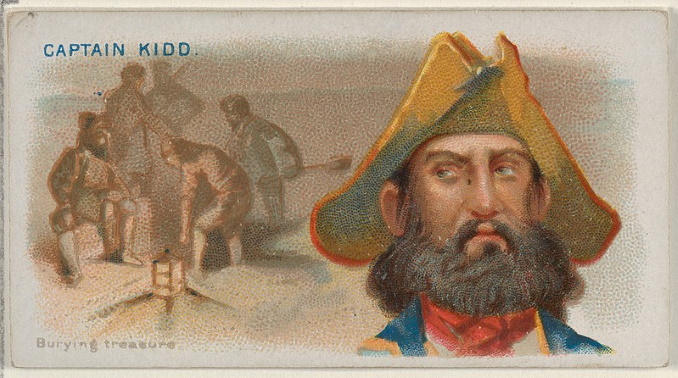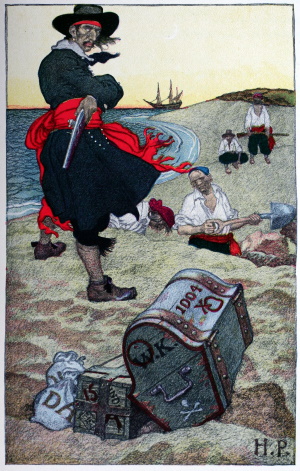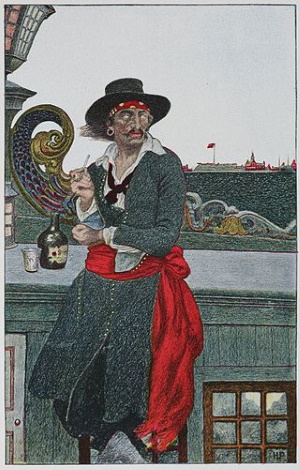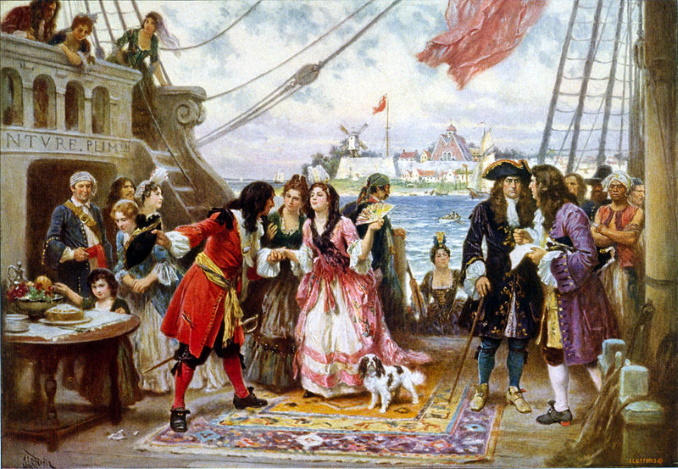Scottish Pirate Captain Kidd And Legend Of His Buried Treasure

The Scottish city of Dundee (Scottish Gaelic: Dùn Dè or Dùn Dèagh) stands on the north bank of the Firth of Tay (Scottish Gaelic: Linne Tatha) which feeds into the North Sea on Scotland’s eastern coast. There are many notable people who were born or associated with Dundee, but there are few who have so much myth and legend surrounding them than Captain William Kidd. This notorious Scottish pirate was born in Dundee in around 1655. He emigrated to New York and is thought to have become a seaman's apprentice and then by 1689, was a member of a French–English pirate crew sailing the Caribbean. On one such voyage William Kidd became a captain. In 1691 he met and married Sarah Bradley Cox Oort, a wealthy New York widow.
During the war between England and France in the 1690’s, Captain Kidd became a successful privateer in charge of the vessel Blessed William. He was part of a small fleet defending the small English island colony of Nevis and American and English trade routes with the West Indies. The English did not pay the sailors for their defensive services, telling them instead to gain their income from the capture of enemy ships that had valuable cargo. These actions also included the attack and plunder of ports on French island colonies.

Captain Kidd had the misfortune to be involved as a privateer/pirate at a time when the rules changed and the privateer/pirate became an outlaw. Privateers were pirates authorised by their government to attack and pillage ships of enemy nations. In a manner he was caught between two stools. On 11 December 1695, Richard Coote, 1st Earl of Bellomont, who was a member of the English Parliament and a colonial governor in New York, Massachusetts, and New Hampshire, met with Captain Kidd. He requested that Captain Kidd attack other pirate ships along with any enemy French ships with whom the English were at war. This enterprise was commissioned by several English Lords. The aim being to seize all loot and return to England where the treasure would be shared among Captain Kidd, his crew, and the Lord investors. It was to result in a voyage, more than any other, that was to cement Captain Kidd's reputation as a pirate and his image in history and folklore.
In late January 1698, they sighted the ship Quedagh Merchant. Captain Kidd and his crew attacked and took the ship and its valuable cargo, rumoured to be worth 70,000 pounds. However, the problem was that the ship was Indian owned and under hire by Armenian merchants and so flying Armenian colours, it was captained by an Englishman, and had a mostly Indian crew. The factor that made Captain Kidd think that it was a legitimate target, and therefore appropriate to the terms of his commission, was that the ship's voyage had been promised safe passage by the French. Quedah Merchant's Captain Wright, subsequently informed him that an agent for the English East India Company had also brokered the voyage.

This was clearly developing into a problem for Captain Kidd because looting this ship could raise major concerns in England. Nevertheless, he decided that his crew could vote on whether to take the ship and its cargo which they agreed to do. At this stage he did not understand the seriousness of his situation. Along with the Adventure Galley, Quedagh Merchant, and Rouparelle, another ship captured by Captain Kidd and given the name, November, they set sail for Cochin and Kalliguilon harbour. The idea being to sell some of the goods to finance his trip back to England. Much of the cargo was sold for gold. However, four ships of the Dutch East India Company were pursuing him by this time. So Kidd gave orders that his group of three ships separate and meet again at St. Mary's Island in Madagascar.
On arriving at St. Mary's Island, he made the decision to attack a ship belonging to pirate, Robert Culliford. When the other ships, November and Quedagh Merchant, arrived at the island things did not go according to plan. The majority of his crew mutinied and went over to Robert Culliford. With the few crew members that remained loyal he negotiated to retain their share of the treasure. He set off on Quedagh Merchant which he now named the Adventure Prize. His aim was to get to New York, avoiding main shipping ports. It was on this journey that he first learned that he was now a wanted pirate and there were orders to arrest Captain Kidd and his crew. He bought another ship, then left his other ship Adventure Prize and his remaining crew, off the small island of Santa Catalina, with a promise to return.
Captain Kidd had decided to continue his journey towards New York. In his mind appeared to be a determination to persuade Bellomont and his backers that he was still loyal to them and not a pirate. Captain Kidd was eventually persuaded to go to Boston, by a false promise of clemency by Bellomont. He was arrested. However, he refused to reveal the location of the Adventure Prize. He thought the treasure aboard the ship could be used as barter for his freedom. Captain Kidd is also said to have deposited some of his treasure on Gardiners Island, located in the southeastern end of Suffolk County, New York. Other islands are also said to contain the buried treasure of Captain Kidd. Again hoping to use his knowledge of the location of this buried treasure as a bargaining tool. He was imprisoned for over a year before being sent back to England. He faced charges of five counts of piracy and the murder, found guilty and on 23rd may 1701 was public executed by hanging.

There is no doubt that the exploits of Captain Kidd caught the imagination of the public at the time of his trial and have ever since. Mythology and legend have inevitably grown with stories of piracy on the high seas, intrigue, mutiny and buried treasure. They have inspired and contributed to literature, such as Treasure Island by Scottish author Robert Louis Stevenson, as well as poems and songs. There is also the lure of undiscovered buried treasure which has been a lure to treasure hunters ever since his death. Searches for Caotain Kidd’s hidden booty have been conducted on Oak Island in Nova Scotia; in Suffolk County, Long Island in New York where Gardiner's Island is located; Charles Island in Milford, Connecticut; the Thimble Islands in Connecticut; Cockenoe Island in Westport, Connecticut and other places. However, it seems only one person really knows the location of this hidden treasure and he has taken that secret with him to the grave.
- Scottish
- English





